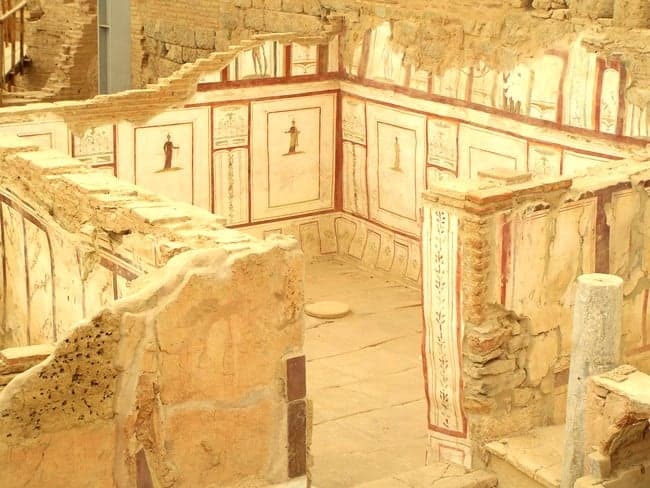The Terrace Houses of Ephesus, nestled on the hillside opposite the Temple of Hadrian, are an extraordinary archaeological discovery that offer an intimate view of life among the Roman elite. Often referred to as “the houses of the rich,” these homes have provided historians and archaeologists with invaluable insights into the daily lives, customs, and societal structure of ancient Rome. Built on the principles of the Hippodamian plan, which divided cities into a grid system with roads intersecting at right angles, the houses were designed not only for functionality but also for elegance and luxury.
Layout and Architecture
The Terrace Houses consist of six residential units spread across three levels on the lower slopes of Bulbul Mountain. These structures date from the 1st century BC to the 7th century AD, highlighting their long period of use and evolution. The architecture is a testament to Roman ingenuity, combining both utility and aesthetics. The houses are characterized by their intricate mosaics, frescoes, and advanced engineering techniques. These decorations and structural elements provide a rich narrative of the artistic and technical advancements of the period.

One of the most fascinating aspects of these homes is the presence of advanced plumbing systems, which included indoor baths and running water, a luxury that underscores the Roman focus on comfort and hygiene. These features are among the earliest examples of urban infrastructure, demonstrating how Roman society valued both practicality and luxury in its domestic spaces.
Artistic Achievements
The frescoes and mosaic floors found within the Terrace Houses are particularly remarkable. The walls are adorned with scenes ranging from mythological stories to everyday life, showcasing not only the aesthetic preferences of the time but also providing a glimpse into the values and beliefs of Roman society. The mosaics, in particular, are vibrant and intricately designed, depicting various themes such as animals, gods, and geometric patterns. These artworks were not merely decorative but also conveyed the status and cultural sophistication of the homeowners.

Social and Economic Insights
The layout of the Terrace Houses provides a clear indication of the social dynamics of the period. The homes were designed to cater to both private and public life, reflecting the Roman understanding of status, privacy, and social hierarchy. The presence of private baths and multiple entrances suggests a careful consideration of the need for both personal space and the ability to entertain guests or conduct business in a dignified manner. This division of space is indicative of the importance of public visibility and social interactions in the Roman world.

Moreover, the materials used in the construction and decoration of these homes speak volumes about the wealth and social standing of their inhabitants. Luxurious materials such as marble, precious stones, and imported goods suggest that the homes were built for individuals who were part of the wealthy elite. Ephesus, one of the largest and most prosperous cities in the Roman Empire, was a major center of commerce, and the Terrace Houses are a direct reflection of the economic prosperity of the city during the Roman era.
Conclusion: A Window into Roman Life
In conclusion, the Terrace Houses of Ephesus stand as a remarkable testament to the grandeur and sophistication of Roman life. These houses provide a rare and valuable opportunity to understand the domestic world of the Roman elite, shedding light on their architecture, art, social dynamics, and economic prosperity. The discovery of these homes has not only enriched our knowledge of Roman domestic life but also enhanced our understanding of the broader Roman Empire, offering a deeper appreciation of its enduring legacy in the world of antiquity.

